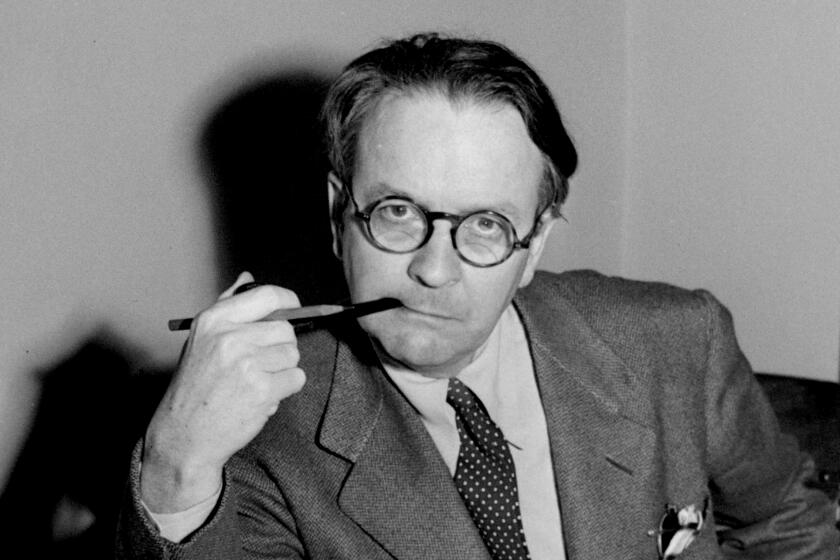‘Shocking True Story’ by Henry E. Scott
- Share via
Anyone familiar with James Ellroy’s “L.A. Confidential,” or the razor-sharp film adaptation, will recall the sleazy magazine whose insatiable desire for nasty stories about Hollywood celebrities drove the plot.
Ellroy called it Hush-Hush, but his model was Confidential, king of the scandal sheets from 1952 to 1957, when a string of lawsuits forced publisher Robert Harrison to cut a deal with the studios and quit snooping for the dirty details of stars’ all-too-human behavior.
After reading “L.A. Confidential,” Henry E. Scott tells us in the acknowledgments to “Shocking True Story,” he looked for a book about Confidential: “Not finding one, I decided to write my own.”
The resulting volume, slim yet still padded with photos and extensive excerpts from Confidential, could easily have been a long magazine article -- except that Tom Wolfe got there first, with a typically hyperbolic 1964 Esquire piece.
Whether or not it was “the most scandalous scandal magazine in the history of the world,” as Wolfe declared, Confidential certainly made studios and stars the maddest. It was the first publication to refuse to play by the unwritten rules that guided tame fan magazines such as Photoplay, which in return for access served up sanitized stories depicting celebrities as home-loving, happily married paragons.
Hardly, sneered Confidential. Relying on an army of paid informers, it dished up revelations of extramarital, homosexual and interracial sex; drug use; neglected children; mistreated ex-wives; and communist pasts that in the 1950s were considered just as disgraceful as personal peccadilloes.
To add insult to injury, Scott notes, most of the stories were true. Until Confidential’s fact-checking department began to slip in 1957, Harrison never settled a lawsuit and ran only one retraction. (That was after a 1953 story calling Tony Bennett’s manager a mobster: The manager got a retraction, according to the author, after he “dangled Harrison upside down from his office window.”)
Harrison followed the advice of his lawyer “to print slightly less than [Confidential] knew,” so that, for example, an angry star protesting an article accusing him of adultery would be told that the magazine had proof his paramour was a minor, and that it would come out in court if he sued.
There’s merit in Harrison’s claim that Confidential bared Hollywood’s hypocrisy. Its 1955 exposé of Desi Arnaz’s philandering was far more accurate than the Look article published a month earlier that had portrayed Lucy and Desi as the ideal American family.
Tab Hunter, one of many gay stars outed by Confidential, acknowledged in his 2005 autobiography that while fan magazines’ depictions of him as “every girl’s dream [were created] virtually out of whole cloth,” the truth, ironically, was told by a tabloid “gleefully making a buck by turning over every last rock in Eisenhower’s buttoned-down America.”
The social context provided by Hunter is largely absent from Scott’s text. He doesn’t address why Confidential’s revelations attracted millions of readers, even though earlier Hollywood scandals had forced the studios to police both their films and their stars. By the 1950s, the public seemed more titillated than outraged; Hunter, Arnaz and other major celebrities survived Confidential’s attentions, although some smaller fry did not.
Only Hollywood was shocked by the breakdown of the gentlemen’s agreement that had preserved a facade most Americans knew to be a crock. The movie industry was important enough to California that the state attorney general got the grand jury indictment that eventually drove Confidential out of business.
Still, the magazine’s imitators kept publishing, and its legacy is alive in today’s supermarket scandal sheets and tabloid TV shows. Scott takes note of this, but again does not consider the wider issues, such as the way Confidential’s coarse, knowing tone and obsession with behind-the-scenes dirt has infiltrated even the coverage of national elections.
Instead, he confines himself to an entertaining, if somewhat skimpy history of the magazine’s five-year heyday. It’s hard not to be amused by the excerpts that precede each chapter, rife with such ur-1950s characterizations as “double-standard dollies” (lesbians) and “cuddle-for-cash cuties” (prostitutes).
The punchy, trashy prose becomes even funnier when we learn that Harrison, who had his first success publishing girlie magazines, believed that “with Confidential, I have finally gone respectable.”
But the joke becomes decidedly grim in the story of anti-communist crusader Howard Rushmore, who was promoted to editor-in-chief in 1954, and whose disinterest in fact-checking provoked most of the lawsuits that speeded Confidential’s demise.
In January 1958, less than two months after Harrison settled the California case by agreeing to a “hands off Hollywood policy,” the hard-drinking, unstable Rushmore shot his estranged wife and then himself in a New York taxi.
A photo of the cab’s bloodstained interior, complete with corpses, adjoins Scott’s two-paragraph wrap-up of Harrison’s final years (he died in 1978) -- a fitting close to a book that provides plenty of juicy tidbits but has little interest in a broader point-of-view.
Smith is the author of “Real Life Drama: The Group Theatre and America, 1931-1940.”
More to Read
Sign up for our Book Club newsletter
Get the latest news, events and more from the Los Angeles Times Book Club, and help us get L.A. reading and talking.
You may occasionally receive promotional content from the Los Angeles Times.









